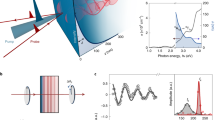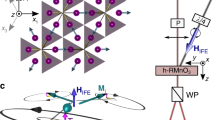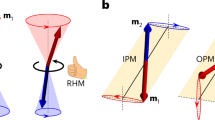Abstract
Antiferromagnets are of potential use in the development of spintronic devices due to their ultrafast dynamics, insensitivity to external magnetic fields and absence of magnetic stray fields. Similar to their ferromagnetic counterparts, antiferromagnets can store information in the orientations of the collective magnetic order vector. However, the readout magnetoresistivity signals in simple antiferromagnetic films are weak, and reorientation of the magnetic order vector via optical excitation has not yet been achieved. Here we report the reversible and reproducible quenching of antiferromagnetic CuMnAs into nano-fragmented domain states using either electrical or ultrashort optical pulses. The changes in the resistivity of the system approach 20% at room temperature, which is comparable to the giant magnetoresistance ratios in ferromagnetic multilayers. We also obtain a signal readout by optical reflectivity.
This is a preview of subscription content, access via your institution
Access options
Access Nature and 54 other Nature Portfolio journals
Get Nature+, our best-value online-access subscription
$29.99 / 30 days
cancel any time
Subscribe to this journal
Receive 12 digital issues and online access to articles
$119.00 per year
only $9.92 per issue
Buy this article
- Purchase on Springer Link
- Instant access to full article PDF
Prices may be subject to local taxes which are calculated during checkout






Similar content being viewed by others
Data availability
The data that support the plots within this paper and other findings of this study are available from the corresponding author upon reasonable request.
References
Néel, L. Magnetism and local molecular field. Science 174, 985–992 (1971).
Shick, A. B., Khmelevskyi, S., Mryasov, O. N., Wunderlich, J. & Jungwirth, T. Spin–orbit coupling induced anisotropy effects in bimetallic antiferromagnets: a route towards antiferromagnetic spintronics. Phys. Rev. B 81, 212409 (2010).
Park, S. R., Kim, C. H., Yu, J., Han, J. H. & Kim, C. Orbital-angular-momentum based origin of Rashba-type surface band splitting. Phys. Rev. Lett. 107, 156803 (2011).
Chen, H., Niu, Q. & Macdonald, A. H. Anomalous Hall effect arising from noncollinear antiferromagnetism. Phys. Rev. Lett. 112, 017205 (2014).
Nakatsuji, S., Kiyohara, N. & Higo, T. Large anomalous Hall effect in a non-collinear antiferromagnet at room temperature. Nature 527, 212–215 (2015).
Železný, J. et al. Relativistic Néel-order fields induced by electrical current in antiferromagnets. Phys. Rev. Lett. 113, 157201 (2014).
Wadley, P. et al. Electrical switching of an antiferromagnet. Science 351, 587–590 (2016).
Železný, J., Wadley, P., Olejník, K., Hoffmann, A. & Ohno, H. Spin transport and spin torque in antiferromagnetic devices. Nat. Phys. 14, 220–228 (2018).
Bodnar, S. Y. et al. Writing and reading antiferromagnetic Mn2Au by Néel spin–orbit torques and large anisotropic magnetoresistance. Nat. Commun. 9, 348 (2018).
Jungwirth, T., Marti, X., Wadley, P. & Wunderlich, J. Antiferromagnetic spintronics. Nat. Nanotechnol. 11, 231–241 (2016).
Baltz, V. et al. Antiferromagnetic spintronics. Rev. Mod. Phys. 90, 015005 (2018).
Jungwirth, T. et al. The multiple directions of antiferromagnetic spintronics. Nat. Phys. 14, 200–203 (2018).
Němec, P., Fiebig, M., Kampfrath, T. & Kimel, A. V. Antiferromagnetic opto-spintronics. Nat. Phys. 14, 229–241 (2018).
Šmejkal, L., Mokrousov, Y., Yan, B. & MacDonald, A. H. Topological antiferromagnetic spintronics. Nat. Phys. 14, 242–251 (2017).
Gomonay, O., Baltz, V., Brataas, A. & Tserkovnyak, Y. Antiferromagnetic spin textures and dynamics. Nat. Phys. 14, 213–216 (2018).
Daughton, J. M. Magnetoresistive memory technology. Thin Solid Films 216, 162–168 (1992).
Wadley, P. et al. Current polarity-dependent manipulation of antiferromagnetic domains. Nat. Nanotechnol. 13, 362–365 (2018).
Wang, M. et al. Spin flop and crystalline anisotropic magnetoresistance in CuMnAs. Phys. Rev. B 101, 094429 (2020).
Chappert, C., Fert, A. & Van Dau, F. N. The emergence of spin electronics in data storage. Nat. Mater. 6, 813–823 (2007).
Kimel, A. V. & Li, M. Writing magnetic memory with ultrashort light pulses. Nat. Rev. Mater. 4, 189–200 (2019).
Wörnle, M. S. et al. Current-induced fragmentation of antiferromagnetic domains. Preprint at https://arxiv.org/pdf/1912.05287.pdf (2019).
Wadley, P. et al. Tetragonal phase of epitaxial room-temperature antiferromagnet CuMnAs. Nat. Commun. 4, 2322 (2013).
Krizek, F. et al. Molecular beam epitaxy of CuMnAs. Phys. Rev. Mater. 4, 014409 (2020).
Shi, J. et al. Electrical manipulation of the magnetic order in antiferromagnetic PtMn pillars. Nat. Electron. 3, 92–98 (2020).
Phillips, J. C. Axiomatic theories of ideal stretched exponential relaxation. J. Non Cryst. Solids 352, 4490–4494 (2006).
Aharoni, A. Effect of a magnetic field on the superparamagnetic relaxation time. Phys. Rev. 177, 793 (1969).
Baumgartner, M. et al. Spatially and time-resolved magnetization dynamics driven by spin–orbit torques. Nat. Nanotechnol. 12, 980–986 (2017).
Gerstner, W. & Kistler, V. M. Spiking Neuron Models (Cambridge Univ. Press, 2002).
Kurenkov, A. et al. Artificial neuron and synapse realized in an antiferromagnet/ferromagnet heterostructure using dynamics of spin–orbit torque switching. Adv. Mater. 31, 1900636 (2019).
Li, Y. Y. Domain walls in antiferromagnets and the weak ferromagnetism of Fe2O3. Phys. Rev. 101, 1450–1454 (1956).
Gregg, J. F. et al. Giant magnetoresistive effects in a single element magnetic thin film. Phys. Rev. Lett. 77, 1580–1583 (1996).
Máca, F. et al. Physical properties of the tetragonal CuMnAs: a first-principles study. Phys. Rev. B 96, 094406 (2017).
Grzybowski, M. J. et al. Imaging current-induced switching of antiferromagnetic domains in CuMnAs. Phys. Rev. Lett. 118, 057701 (2017).
Olejník, K. et al. Terahertz electrical writing speed in an antiferromagnetic memory. Sci. Adv. 4, eaar3566 (2018).
Acknowledgements
We acknowledge J. Kastil and M. Míšek for experimental support. This work was supported in part by the Ministry of Education of the Czech Republic infrastructure grants CzechNanoLab no. LM2018110, no. LNSM-LNSpin and MGLM no. LM2018096, the Czech Science Foundation grant no. 19-28375X, the Charles University grant GA UK nos. 886317 and 1582417, the EU FET Open RIA grant no. 766566 and the Engineering and Physical Sciences Research Council grant no. EP/P019749/1. P.W. acknowledges support from the Royal Society through a University Research Fellowship. T.J. acknowledges support from the Neuron Foundation Prize and K.O. from the Neuron Foundation Impuls grant.
Author information
Authors and Affiliations
Contributions
K.O., Z.K. and T.J. conceived and designed the project. Z.K., M.S., J.Z., F.K., K.O., P.W., K.W.E., S.R., O.J.A., F.M. and S.S.D. performed experiments. K.O., P.N., P.W., K.W.E., J.W., X.M., M.S.W., P.G. and T.J. analysed data. V.N., F.K. and R.P.C. contributed materials. K.O. and T.J. wrote the manuscript.
Corresponding author
Ethics declarations
Competing interests
The authors declare no competing interests.
Additional information
Peer review information Nature Electronics thanks the anonymous reviewers for their contribution to the peer review of this work.
Publisher’s note Springer Nature remains neutral with regard to jurisdictional claims in published maps and institutional affiliations.
Supplementary information
Supplementary Information
Supplementary Figs. 1–15 and Notes 1 and 2.
Rights and permissions
About this article
Cite this article
Kašpar, Z., Surýnek, M., Zubáč, J. et al. Quenching of an antiferromagnet into high resistivity states using electrical or ultrashort optical pulses. Nat Electron 4, 30–37 (2021). https://doi.org/10.1038/s41928-020-00506-4
Received:
Accepted:
Published:
Issue Date:
DOI: https://doi.org/10.1038/s41928-020-00506-4
This article is cited by
-
Effective electrical manipulation of a topological antiferromagnet by orbital torques
Nature Communications (2024)
-
Antiferromagnetic half-skyrmions electrically generated and controlled at room temperature
Nature Nanotechnology (2023)
-
Electrical and magnetic anisotropies in van der Waals multiferroic CuCrP2S6
Nature Communications (2023)
-
Current-driven writing process in antiferromagnetic Mn2Au for memory applications
Nature Communications (2023)
-
Terahertz Néel spin-orbit torques drive nonlinear magnon dynamics in antiferromagnetic Mn2Au
Nature Communications (2023)



